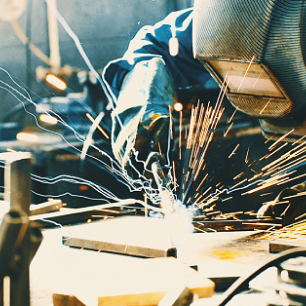Jump to:
The Real Cost of Cutting Wheels
Discover how wheel choice affects productivity, material waste, and safety.
Abrasive cutting wheels provide a quick and accurate way to cut through steel and other materials, such as aluminum, titanium, and Inconel, when preparing many parts for industrial and manufacturing operations. However, selecting the right wheel for the application plays a critical role in ensuring proper results and helping operations meet their goals.
While it is easy to view cutting wheels as consumables and choose them based solely on the lowest purchase price, this approach overlooks hidden costs that can add significant time and money in an operation. Cutting wheel selection and use also have a substantial impact on safety.
Problems can arise when the wrong wheel is used or when the correct wheel is used improperly. Selecting the right cutting wheel for the job can reduce cutting time, extend product life, minimize product waste and material scrap, and help optimize operator safety.
The Impact of Cutting Wheels on Total Costs
In manufacturing operations, time is money. Companies likely have customers waiting on them to deliver the final product on time and within budget. Wasted time, materials, and consumables all add unnecessary costs to the equation. This makes it important to understand the total cost involved with the cutting wheels being used. Not only can this help save time and money, but understanding the true costs also helps determine profitability for each job. Of course, the true cost of a cutting wheel can vary greatly from operation to operation. It depends on many factors related to the overall application and how much cutting is involved. Some key factors that affect a cutting wheel’s total cost include the initial price, labor (time spent on cutting and wheel changeover), wheel lifespan, and operator technique.
While the upfront cost of a cutting wheel is tangible and can be seen on an invoice, the operator’s time is the most expensive component of the cutting application. Labor time that is wasted or saved is less tangible but has a significant impact on an operation’s overall costs and efficiency. The number of wheel changeovers required is part of this, as wheel changeover can be extremely time-consuming depending on the application.
Take an operation that pays $1 per wheel but only gets five cuts out of each wheel, making the wheel’s cost per cut 20 cents. Compare that to an operation that buys longer-lasting wheels at $2 and gets 30 cuts out of each one. The material cost per cut is less than seven cents. On the surface, the longer-lasting wheel appears to cost twice as much as the $1 wheel. However, the operation can buy fewer wheels per month, save significant labor time in wheel changeover, and reduce material costs. This must be measured against the speed of cut for the wheel with the shorter life, because typically, short-lasting wheels cut much faster than long-lasting wheels. This analysis will show the overall cost per cut.
Understanding a wheel’s true costs can help make those costs more tangible and identify potential savings. Productivity, throughput, and labor costs are all tied together, and the choice of cutting wheel impacts all these factors.
Choosing the wrong cutting wheel for the job can result in the following:
Shorter Wheel Life. If the wheel is too soft for the base material or the application’s needs, there will be fewer cuts per wheel. This results in a higher cost per cut and increased total cost (reducing the wheel’s return on investment).
Increased Labor. If the wheel is too hard, it will not cut effectively. Users will get many cuts from the wheel, but it will take considerably longer to make those cuts, increasing labor costs.
More-Frequent Wheel Changeover. A shorter wheel life can also create bottlenecks in the process. While faster cutting helps maintain high throughput, it can also lead to more frequent wheel changeovers, which greatly reduce value-added productive work time. Wheel life vs. cut rate should be evaluated to determine overall costs.
Too Much Pressure. When a wheel is wrong for the job, the operator may feel the need to use more pressure to get the work done efficiently. Excess pressure is one of the main causes of injuries in metal cutting. In addition, too much pressure increases heat buildup, which can decrease wheel life and result in costly rework if the workpiece is affected by the heat. Aluminum, for example, has high thermal conductive properties, and excess heat buildup can warp the material. Too much pressure can also damage the right-angle grinding tool being used by pushing the motor too hard. An over-heated tool could result in expensive repair, downtime, or replacement. Wheel failure, grain loading, decreased productivity, and damaging the workpiece are all possible outcomes of too much pressure on the wheel.
Increased Time for Burr Removal. Some wheels introduce more friction in the cutting process, which can produce more burrs and increase the time spent on burr removal. To avoid this issue, choose a very thin, fast-cutting wheel that reduces friction to help reduce rework and time for burr removal.
Issues with Fitup. When the wrong wheel is used for the job, the cut may be less precise. This can result in issues with fitup during welding, requiring operators to use more filler metal. This increases the cost of the weld and takes more time. Using a better wheel for the job can improve part fitup for better weld quality and a lower rejection rate.
Choose the Right Cutting Wheel for the Job
To choose the right cutting wheel, the first critical step for any operation is to identify its goals and pain points. Is the goal to increase throughput? To increase the time operators spend welding? To use less filler metal when welding? Certain products can help achieve goals faster and better. Working with an abrasives expert to conduct a complete evaluation helps greatly in determining priorities and uncovering useful data. This process can be especially beneficial for operations that complete a high volume of cutting, experience high cutting wheel costs or short wheel lifespans, or seek to address safety concerns.
When choosing a cutting wheel, there are many options and factors to consider, including the following:
Base Material. This is the most important consideration when choosing a wheel. Cutting aluminum requires a wheel designed for that material to prevent loading. And cutting harder materials like titanium, Inconel, armored steel, or high-nickel-alloy steel is best done with a ceramic wheel. Operations will waste significant time and money if the wrong wheel for the material is used.
Wheel Type. Type 1 wheels have a flat profile that allows a deeper reach. Type 27 wheels have a depressed center or raised hub that provides added clearance when working at a constrained angle.
Wheel Diameter. In the United States, 4.5- and 6-in. wheels are the most popular sizes used on right-angle grinding tools. A 6-in. wheel will, by nature, provide more cuts than a 4.5-in. wheel and allow for easier access to hard-to-reach areas that could be interfered with by the tool profile.
Wheel Thickness. This plays a role in various materials. For example, with sheet metal, thin (0.045-in.) and ultrathin (1-mm) wheels are best. Ultrathin 1-mm wheels cut quickly and produce fewer burrs because they generate less friction. Combination wheels could also be a good choice in some applications, as these are 1/8-in.-thick wheels that can cut and safely do light grinding.
Grains/Grit and Bonds. Some cutting grains commonly used in bonded abrasive cutting wheels are aluminum oxide, silicon carbide, zirconia alumina, and ceramic alumina. Grains should be chosen based on factors such as the materials being cut, potential heat buildup, and cost. The grit refers to the size of each individual grain. Different grit sizes, ranging from coarse to fine, affect the wheel's cut rate. Some grains and grit sizes are more aggressive and provide faster cutting when combined with the appropriate bond.
The bond is the substance that holds the abrasive grain together. The strength or hardness of the bond determines how well the wheel can handle different materials. The bond also affects the wheel’s lifespan and cutting rate. Harder bonds typically have a longer lifespan and are better for softer materials, while softer bonds have a shorter lifespan but shed grains more quickly, providing a faster cut.
For the best results for a specific operation, consult an expert with your abrasive manufacturer to determine the appropriate grain, grit, and bond combination for the most effective cutting wheel to meet your goals.
Proper Tooling. In most industrial and manufacturing applications, cutting wheels are used on right-angle grinding tools. Be sure that the tool amperage or horsepower is sufficient to maintain the cutting wheel speed. Higher-powered tools are necessary to properly break down the harder bonds and grains in higher-performing products. Using a tool that doesn’t have sufficient power means the wheel won’t perform as designed.
Keep Safety at the Forefront
Cutting wheels can greatly impact operator safety in any facility. Choosing the right wheel for the job plays a key role in safety, but it’s also important to train operators to properly and efficiently use that specific wheel to help avoid injuries.
Abrasive manufacturers can provide safety and product-use training. For example, Weiler Abrasives provides SPOT safety training and offers the Weiler Consumable Productivity program.
Choosing the proper cutting wheel for the job and following best practices for its use can help operations reduce costs by improving operator safety, minimizing time spent on wheel changeover, prolonging the wheel’s effective cutting life, and decreasing rework and the amount of filler metal needed to produce a quality weld. In many cases, buying higher-priced, high-performance cutting wheels ultimately provides a lower overall cost of use and helps operations reach their goals.
This article was written by David Jescovitch (abrasive specialist manager, Weiler Abrasives) and John Hines (district sales manager, Weiler Abrasives) for the American Welding Society.


